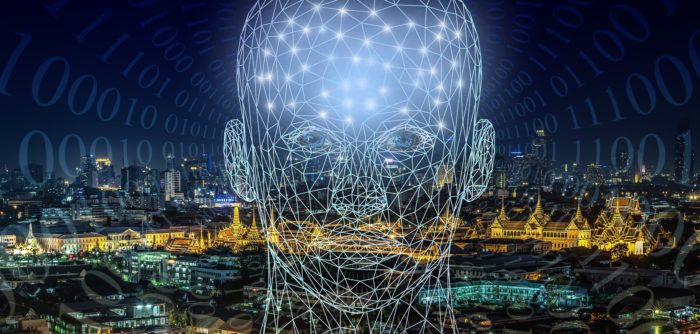
Artificial intelligence is doing some amazing things in 2020.
It’s driving our cars.
It can create art and music.
It’s reading our brain waves and letting us control computers and other devices with our minds.
AI will only get better at all these things, and some new developments that we haven’t even thought of could be just around the corner.
We asked top experts in the field, people actually building the brave new world of AI, to stretch their brains and come up with some predictions.
Let’s take a mental field trip to 2030 and check out the possibilities.
1. You’ll be able to choose how things look, feel, and smell
If you want to redecorate your living room today you’ve got to get rid of your old furniture and get a bunch of new stuff.
In ten years you might be changing not only the way your couch looks but even how it feels when you sit on it, all at the flip of a switch. Want it to look and feel like a leather couch? No problem. Tired of those flowers on the table? Presto, now they look and smell like roses.

“While some of the building blocks are there today, the big advancement would be in synthesizing touch. How can you make a surface feel different to human touch,” Zohar Gilad, CEO at shopping optimization platform InstantSearch, told Hypergrid Business.
While the convenience would be amazing, the biggest benefit could be to our planet.
“The bigger question is the environmental impact,” said Gilad. “Every one of us is guilty of overconsuming the planet’s resources. We buy new clothes, furniture, and stuff, not because the old is not usable, but rather to change, refresh or revitalize,” he said.
Being able to instantly satisfy the human need for change and save the planet at the same time sounds like a no-brainer.
2. National identities could be seriously blurred
If you live in France and only speak French, you might not have easy access to a lot of online content from America. Those videos and articles sure look cool but if only you could understand what the heck they’re saying, and the text translations just aren’t that good if they’re even available.
In 2030, there might be no gap between a person posting content online in one country and another person somewhere else in the world being able to instantly access and understand it in their own language.

“Audiences of media and entertainment will also likely expand beyond national and linguistic borders, as natural language processing, automatic speech recognition, and machine translation disseminates content across languages instantaneously,” Venkat Viswanathan, chairman at digital analytics firm LatentView. told Hypergrid Business
The way the world interacts could change significantly if everyone understands each other without the lost in translation part.
“Interestingly, national identities might become less pronounced in this environment as content becomes a cross-cultural connector and insulator from more domestic conceptions of culture,” said Viswanathan.
“Friendships born out of shared interest and content communities will increasingly create egalitarian social networks that are geographically diverse,” he said.
3. Your job won’t exist
It’s not all sunshine and butterflies. While the robots probably won’t rise up and kill us in 2030, they just might take away that job you thought was irreplaceable.

“By 2030, AI-created unemployment will be a major societal concern. Roles such as car or truck drivers, equipment operators, medical diagnostic professionals, and lawyers will see a dramatic shift to AI-enabled intelligence and autonomy and therefore job-losses for humans,” Pandurang Kamat, chief technology officer at global solutions company Persistent Systems, told Hypergrid Business,
Workers will need to be retrained as AI advances and takes over jobs that only humans did.
Governments will have to be proactive in creating new laws and programs to protect and reeducate the displaced workforce.
“As AI progresses, the role of government becomes more and more important. The need to study and understand AI technology is crucial, but there’s also a humanitarian need to proactively create programs for those about to be displaced,” said Andrew Bocskocsky, CEO of B2B search engine Grata.
“Jobs that rely on emotional intelligence, like sales, leadership and management are safe in the next decade,” he added.
4. Automation’s the name of the game
Your car won’t even have a steering wheel in ten years. It’ll drive you where ever you want to go and drones will deliver whatever you want to buy or eat.

“Supply-chain will be automated and machines will automatically replenish stocks without human intervention,” Ryohei Fujimaki, CEO of data science platform dotData, told Hypergrid Business.
AI will be everywhere on a consumer and business level, taking care of all those annoying little jobs we’re still doing ourselves.
“This means that bots will handle simple tasks for us like reorganizing our desktop or refilling our Amazon Prime shopping cart and placing the order for you,” added Grata’s Bocskocsky.
5. AI will be embedded in everything from cameras to shoes
Amazon might be able to recommend a good pair of shoes, but once you’ve bought them it doesn’t know what those shoes are up to. Almost anything you buy could be using AI in the future to report how it’s being used.
“If I buy running shoes, they will transmit to the seller how many times I run and the systems will be able to predict when I need new shoes or what else can be proposed to me based on its use patterns,” said Gilad.
AI-imbedded devices could find their way into our creative lives too.
“Video cameras and AI avatars could work with humans to direct and edit high-quality self-made films,” said Viswanathan. “People without any formal music training will be able to leverage specialized hardware powered by AI to produce high-quality music. Increasingly, artistic output will be an AI-assisted endeavor that is limited mostly by creativity rather than skill,” he said.
6. AI will be embedded in our brains
AI could be directly interacting with all our devices and our brains as well.

“In ten years, we will have pinpointed with a good degree of accuracy where every sensation and thought could lie in the brain,” Monte Zweben, CEO of data platform Splice Machine, told Hypergrid Business.
It won’t necessarily be a brain chip either.
“A glass contact lens that connects to your brain doesn’t seem too far-fetched. All the information in the world will be just a thought away,” said Zweben.
Virtual reality gatherings have become more common during the pandemic and those meetings could feel just like the real thing in ten years.
“Being able to embed virtual reality directly into your brain would make virtual meetings feel real, so you could simulate the feeling of being hugged when FaceTiming a friend,” said Zweben.
7. Turing test schmuring test
The Turing test is a test of a machine’s ability to exhibit intelligent behavior equivalent to or indistinguishable from that of a human, and some AI programs are starting to beat it.
The idea of a machine talking and acting like a human may sound novel today, but people could just take this for granted in ten years.
Consumers and corporations will work hand in hand with AI and the lines of whether you’re interacting with humans or computer programs called bots could be totally blurred.

“This combination of bots and humans will grow to be so successful over the next decade that people may not even realize when they’re interacting with a bot vs. a human,” said Grata’s Bocskocksy.
Not only will our AI pals interact with us like they’re humans, but we’ll all have them.
“By 2030, we can expect that everyone- even children- will have some type of virtual assistant,” Ajay Dawar, vice president of product management at digital document transformation company Conga, told Hypergid Business.

And it’ll be smart. “For instance, a nine-year-old may ask an assistant to search the Internet to find the most important content for an assignment, and then copy and paste the information in the document, all while having breakfast,” he said.
AI won’t just help with homework.
“That same child may ask the assistant whether her friend from class has a crush on another classmate – and the assistant will be able to make an accurate prediction based on the digital social interactions and data collected over billions of people,” added Dawar.
8. You don’t need to know a gosh darn thing
We have troubleshooters today for simple tech problems, but soon AIs will be troubleshooting complex industrial problems that currently need highly educated and experienced people.

“Much of the time spent troubleshooting and addressing problems in complex industrial systems today is wasted trying to figure out what’s wrong in the first place,” John Tomizuka, CTO of industrial AR solutions company Taqtile, told Hypergrid Business.
People working in industrial environments today might find themselves digging through a physical manual in an emergency setting if the right person isn’t there to fix the problem. Not so in ten years.
“In time, we will have systems capable of diagnosing problems and leading even novice users through the process of troubleshooting complex challenges,” said Tomizuka.
9. The AI doc knew just what I needed
Doctors are already using AI in 2020 with great results.

“In October, researchers at MIT developed an AI model capable of detecting asymptomatic COVID-19 infections through cellphone-recorded coughs alone,” Matt Jackson at connected platform Insight, told Hypergrid Business.
AI is helping doctors diagnose patients and prepare personalized intervention plans. In the future, it could figure out the entire treatment for them.
“In the next decade, advancements in AI could help predict how a patient’s cancer cells might behave, creating highly customized, targeted treatments for individual patients,” said Jackson.
10. AI won’t kill us all…
Most of us have seen or at least heard of the Terminator movies, where AI-powered robots rise up to destroy humanity, but this doesn’t seem too likely.
“The frightening, futurist portrayals of Artificial Intelligence that dominate films and novels, and shape the popular imagination, are fictional,” said a Stanford study. “In reality, AI is already changing our daily lives, almost entirely in ways that improve human health, safety and productivity,” the study said.
There will be challenges as governments and the workforce will have to adapt to AI’s effects on industry and commerce, but not the “fighting off killer robots in a post-apocalyptic wasteland” kind.

11. … or WILL it?
Here’s one for the pessimists: killer robots.
“The battlefield of the future will be densely populated by a variety of things- some intelligent and some only marginally so — performing a broad range of tasks including sensing, communicating, acting, and collaborating with each other and human warfighters,” states a paper published by the US Army research laboratory back in 2016.
Think that’s far-fetched?
Militaries across the world are already planning on greatly expanding their use of AI and robots on the battlefield.
The head of the UK’s military has said that he expects up to a quarter of all soldiers could be robots by the 2030s.
If the battlefield is populated by a variety of intelligent devices, some of them designed to fight, is it only human vanity that leads us to think we’ll always be in control of our own creation?
